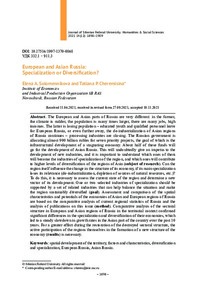Показать сокращенную информацию
European and Asian Russia: Specialization or Diversification?
| Автор | Solomennikova, Elena A. | en |
| Автор | Cheremisina, Tatiana P. | en |
| Автор | Соломенникова, Е. А. | ru_RU |
| Автор | Черемисина, Т. П. | ru_RU |
| Дата внесения | 2021-12-29T08:07:12Z | |
| Дата, когда ресурс стал доступен | 2021-12-29T08:07:12Z | |
| Дата публикации | 2021-12 | |
| URI (для ссылок/цитирований) | https://elib.sfu-kras.ru/handle/2311/145037 | |
| Аннотация | The European and Asian parts of Russia are very different: in the former, the climate is milder, the population is many times larger, there are many jobs, high incomes. The latter is losing population – educated youth and qualified personnel leave for European Russia, or even further away, the de-industrialization of Asian regions of Russia continues – processing industries are closing. The Russian government is allocating almost 900 billion rubles for seven priority projects, the goal of which is the infrastructural development of a stagnating economy. About half of these funds will go for the development of Asian Russia. This will undoubtedly give an impetus to the development of new industries, and it is important to understand which ones of them will become the industries of specialization of the region, and which ones will contribute to higher levels of diversification of the regions of Asia (subject of research). Can the region itself influence the change in the structure of its economy, if its main specialization loses its relevance (de-industrialization, depletion of sources of natural resources, etc.)? To do this, it is necessary to assess the current state of the region and determine a new vector of its development. One or two selected industries of specialization should be supported by a set of related industries that can help balance the situation and make the region sustainably diversified (goal). Assessment and comparison of the spatial characteristics and potentials of the economies of Asian and European regions of Russia are based on the comparative analysis of current regional statistics of Russia and the analysis of publications on this issue (method). Comparative analysis of the sectoral structure in European and Asian regions of Russia in the territorial context confirmed significant differences in the specialization and diversification of their economies, which led to a steady slowdown in growth rates in the Asian part of the country over the past 10 years. For a greater effect during the restoration of the destroyed sectoral structure, the active participation of the regions themselves in the formation of a new structure of the economy (results) is necessary | en |
| Аннотация | Европейская и азиатская части России очень разные: в первой мягче климат, в разы больше население, много рабочих мест, высокие доходы, а вторая теряет население – образованная молодежь и квалифицированные кадры уезжают в европейскую Россию, а то и подальше, продолжается деиндустриализация азиатских регионов – закрываются обрабатывающие производства. Правительство РФ выделяет почти 900 млрд руб. на семь приоритетных проектов, цель которых инфраструктурное развитие стагнирующей экономики, около половины этих средств пойдет на развитие азиатской России. Это, безусловно, даст толчок развитию новых отраслей, и важно понять, какие из них станут отраслями специализации региона, а какие будут поддерживающими, чтобы повысить уровень диверсификации регионов Азии (предмет исследования). Может ли сам регион повлиять на изменение структуры его экономики, если его основная отрасль специализации утрачивает актуальность (деиндустриализация, исчерпание источников природных ресурсов и др.)? Для этого необходимо провести оценку текущего состояния региона и определить новый вектор его развития. Одна-две выбранные отрасли специализации должны поддерживаться набором связанных с ними отраслей, которые могут сбалансировать ситуацию и превратить регион в устойчиво диверсифицированный (цель). Оценка и сравнительный анализ пространственных характеристик и потенциала экономик азиатских и европейских регионов России опираются на анализ актуальной региональной статистики России и анализ публикаций по этой проблеме (метод). Сравнительный анализ европейской и азиатской отраслевой структуры в территориальном разрезе подтвердил значительные различия в специализации и диверсификации их экономик, что привело к устойчивому замедлению темпов роста в азиатской части страны в последнее 10-летие. Для большего эффекта в ходе восстановления разрушенной отраслевой структуры необходимо активное участие самих регионов в формировании новой структуры экономики (результаты) | ru_RU |
| Язык | en | en |
| Издатель | Сибирский федеральный университет. Siberian Federal University | en |
| Тема | spatial development of the territory | en |
| Тема | factors and characteristics | en |
| Тема | diversification and specialization | en |
| Тема | European Russia | en |
| Тема | Asian Russia | en |
| Тема | пространственное развитие территории | ru_RU |
| Тема | факторы и особенности | ru_RU |
| Тема | диверсификация и специализация | ru_RU |
| Тема | европейская Россия | ru_RU |
| Тема | азиатская Россия | ru_RU |
| Название | European and Asian Russia: Specialization or Diversification? | en |
| Альтернативное название | Европейская и азиатская Россия: специализация или диверсификация? | ru_RU |
| Тип | Journal Article | en |
| Контакты автора | Solomennikova, Elena A.: Institute of Economics and Industrial Production Organization SB RAS Novosibirsk, Russian Federation | en |
| Контакты автора | Cheremisina, Tatiana P.: Institute of Economics and Industrial Production Organization SB RAS Novosibirsk, Russian Federation; cherem@ieie.nsc.ru | en |
| Контакты автора | Соломенникова, Е. А.: Институт экономики и организации промышленного производства СО РАН Российская Федерация, Новосибирск | ru_RU |
| Контакты автора | Черемисина, Т. П.: Институт экономики и организации промышленного производства СО РАН Российская Федерация, Новосибирск | ru_RU |
| Страницы | 1898–1909 | ru_RU |
| DOI | 10.17516/1997-1370-0868 | |
| Журнал | Журнал Сибирского федерального университета. Гуманитарные науки. Journal of Siberian Federal University. Humanities & Social Sciences; 2021 14 (12) | en |

